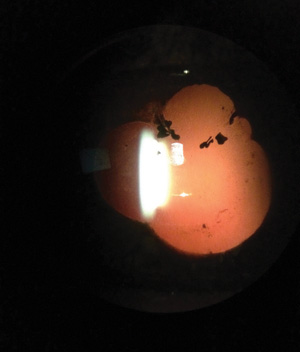
CausesĪnisocoria can be neurological or ocular and causes can range from harmless to life-threatening. The condition occurs for several reasons, and it may or may not be accompanied by other symptoms, depending on the underlying cause. Pupils of different sizes are medically known as anisocoria ( ann-eye-so-CORE-ee-uh). Normally the pupils expand or contract together, with both either being dilated (large) or constricted (small). In low light, they expand, to let more light into the eye, in bright light, they contract to let less light in. The pupils are the black opening located in the center of the eye, which expands and contracts depending on the amount of light.

Treatment: The goal of treatment is to find and address the underlying cause as well as provide supportive care.Diagnosis: Thorough physical examination and detailed eye examination, tonometry to measure the pressure in the eye, ultrasound, fluorescein staining, electroretinography, Schirmer tear test and neurological evaluation.Symptoms: Can vary depending on the underlying cause but aside from abnormal pupil sizes can also include pain in the affected eye, change of eye colour, change in eye size, loss of vision, head tilt, confusion.Causes: There are several causes which include glaucoma, uveitis, corneal ulcer, spastic pupil syndrome, certain medications, tumours, oculomotor nerve paralysis, retinal detachment, Horner’s syndrome, stroke, head trauma, and iris atrophy.The pupils should be the same size in both eyes, and odd-sized pupils can indicate an underlying problem. When it is dark, the pupils are large (dilated), and when it is bright, the pupils are small (constricted). About: The pupils are the black portion of the eyes that change size according to light conditions.However, if you have the symptoms of Horner syndrome described above, or if your pupils change size suddenly throughout your adult life, it is highly recommended to seek medical attention as soon as possible.Different Sized Pupils (Anisocoria) – at a glance For many people who do experience differentiated pupils, it is not a new condition and tends to be present from birth. While most of the time having unequal sized pupils results in little or no damage to one’s vision, for others the impact of differentiated pupils can be life-changing.


When to consult your local independent optician This depends on the type of drug you have taken but in all cases our pupils resume to their regular size once the effects of the drug have worn off. Our pupils commonly increase in size when we are under the influence of recreational drugs which send stimulating signals to our nerves which can either increase or decrease the size of our pupils. If you are experiencing any of these symptoms then you should get medical attention immediately.
#Uneven pupil dilation series#
This syndrome typically results in a reduced pupil size in one eye and is joined by a series of other symptoms such as droopy eyelid and decreased sweating in the impacted side of your face and eye. This syndrome is the outcome of a disruption of nerves between the brain towards the face and eye on one side of the body only. If you are experiencing a reduced pupil size on one side of your face it might be an indication that you are suffering from Horner syndrome. However, if you also experience additional symptoms, such as drooping eyelids or fever, you ought to seek medical attention as soon as possible.

For some people who have anisocoria, there is no impact upon one’s sight, which is termed physiologic anisocoria. This condition means that your pupils will not necessarily be identical. If you happen to notice that your pupils are dilating to different extents at the same time it might be that you have an eye condition called anisocoria. Here are some of the main reasons for why your pupils are different sizes. This is particularly common when other symptoms are present as well. Normally our pupils tend to be identical in terms of when and how much they dilate, but for some people, a differentiated pupil size can be indicative of an underlying health problem. Most of us probably don’t spend much time looking at the shape or size of our pupils.


 0 kommentar(er)
0 kommentar(er)
